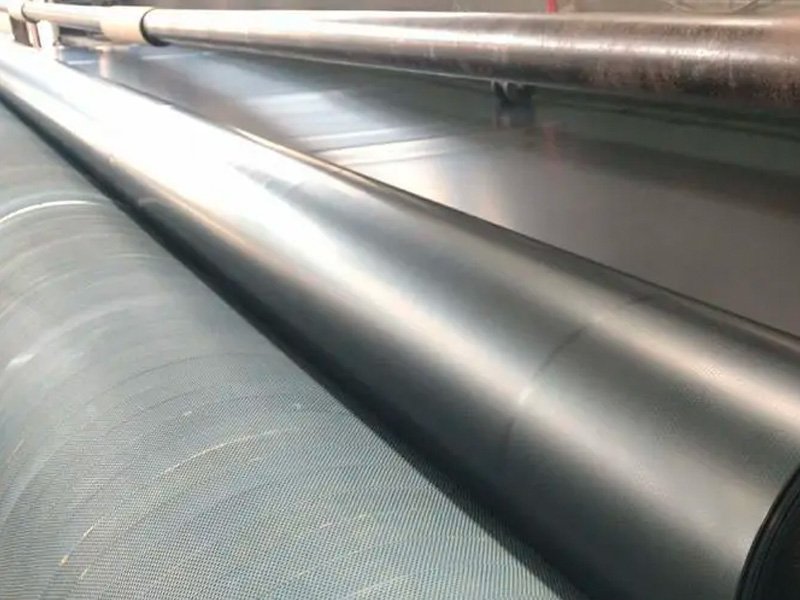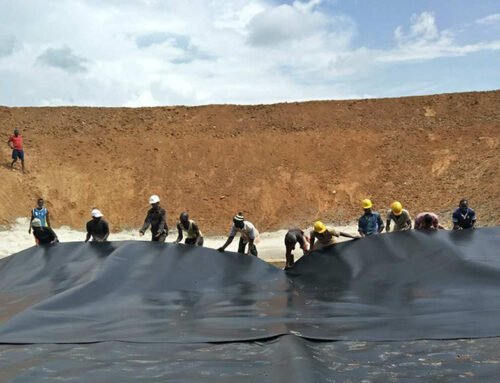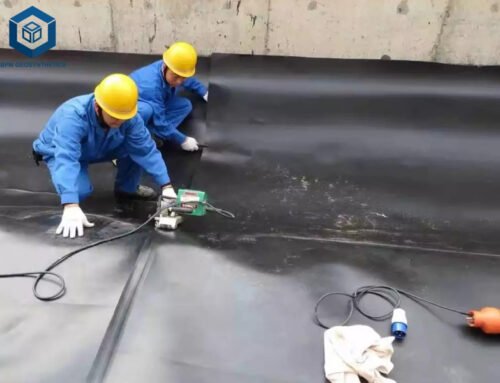LDPE geomembrane vs LLDPE geomembrane, what are key differences in their properties and applications? BPM geomembrane is the leading geomembrane manufacturers and suppliers. We wholesale best LDPE geomembrane and LLDPE geomembrane at competitive factory price. From the geomembrane manufacturer’s view, let’s compare LDPE geomembrane and LLDPE geomembrane.
1.Brief Introduction
LDPE (Low-Density Polyethylene) and LLDPE (Linear Low-Density Polyethylene) geomembrane are both types of geosynthetic liners used in geotechnical and environmental engineering applications.
1.1 LDPE Geomembrane
LDPE is a type of polyethylene, which is a thermoplastic polymer made from the monomer ethylene. LDPE is known for its flexibility, toughness, and chemical resistance. LDPE (Low-Density Polyethylene) geomembrane is is made from low-density polyethylene, which is a flexible and lightweight thermoplastic material. LDPE geomembrane liner offers different characteristics compared to LLDPE geomembrane and HDPE geomembrane. LDPE Geomembranes are specifically designed to provide a barrier against the seepage or leakage of liquids and gases in applications where containment is critical.
1.2 LLDPE Geomembrane
LLDPE is also a type of polyethylene. It is a linear polymer with short branches, resulting in a structure that is more linear than traditional LDPE. LLDPE (Linear Low-Density Polyethylene) geomembrane is a type of synthetic liner used in containment applications. It is made from linear low-density polyethylene, a flexible and durable thermoplastic material. LLDPE geomembrane liners offer specific characteristics that make them suitable for various LDPE geomembrane vs LLDPE geomembrane, what are key differences in their properties and applications? BPM geomembrane is the leading geomembrane manufacturers and suppliers. We wholesale best LDPE geomembrane and LLDPE geomembrane at competitive factory price. From the geomembrane manufacturer’s view, Let’s compare LDPE geomembrane and LLDPE geomembrane.


2 Differences of LDPE Geomembrane vs LLDPE Geomembrane
2.1 Flexibility and stiffness
LDPE (Low-Density Polyethylene) and LLDPE (Linear Low-Density Polyethylene) geomembranes have different levels of flexibility and stiffness due to variations in their molecular structure. Here’s a comparison of their flexibility and stiffness characteristics:
2.1.1 Flexibility
LDPE geomembranes are known for their excellent flexibility. They have a highly branched and amorphous molecular structure, which allows them to exhibit superior flexibility and elongation properties. LDPE geomembranes can conform to irregular surfaces and accommodate ground movements, making them suitable for applications where flexibility is crucial.
LLDPE geomembranes also offer good flexibility, although not as high as LDPE. LLDPE has a linear polymer structure with some branching, which provides it with improved strength and stiffness compared to LDPE. While LLDPE geomembranes are less flexible than LDPE, they still have sufficient flexibility to adapt to moderate ground movements and irregular surfaces.
2.1.2 Stiffness
LDPE geomembranes tend to be less stiff or rigid due to their highly branched molecular structure. This flexibility allows LDPE geomembranes to withstand deformation and elongation without rupturing or tearing. However, the lower stiffness of LDPE geomembranes can sometimes make them less suitable for applications that require higher structural integrity or resistance to mechanical stresses.
LLDPE geomembranes have a more linear and less-branched molecular structure compared to LDPE. This structural difference results in increased stiffness and rigidity. LLDPE geomembranes offer better dimensional stability and higher tensile strength, making them more suitable for applications that require greater structural integrity and resistance to mechanical stresses.
2.2 Chemical Resistance and Compatibility
Both LDPE (Low-Density Polyethylene) and LLDPE (Linear Low-Density Polyethylene) geomembranes offer good chemical resistance, but there are some differences in their chemical compatibility due to variations in their molecular structures. Here’s a comparison of their chemical resistance and compatibility.
2.2.1 Chemical Resistance
LDPE geomembranes exhibit good resistance to a wide range of chemicals, including acids, alkalis, and solvents. They are generally resistant to mild acids and bases, organic solvents, and hydrocarbons. However, LDPE may have limited resistance to strong oxidizing agents and certain strong acids, such as concentrated sulfuric acid or nitric acid.
LLDPE geomembranes offer similar chemical resistance to LDPE. They are resistant to various acids, alkalis, organic solvents, and hydrocarbons. LLDPE geomembranes generally provide good resistance to mild to moderate chemical environments. However, like LDPE, LLDPE may have limited resistance to strong oxidizing agents and certain strong acids.
2.2.2 Compatibility
Compatibility with Specific Chemicals. The chemical compatibility of both LDPE and LLDPE geomembranes depends on the specific chemicals they come into contact with. It is essential to evaluate the type, concentration, and duration of exposure to chemicals in your specific application. Consultation with geomembrane manufacturers or experts is recommended to determine the compatibility of LDPE or LLDPE geomembranes with specific chemicals.
Environmental Stress Cracking. Both LDPE and LLDPE geomembranes can be susceptible to environmental stress cracking when exposed to a combination of stress and certain chemicals. Environmental stress cracking can cause cracks and failures in the geomembrane. Therefore, it is important to assess the potential for environmental stress cracking in your specific application and select a geomembrane that offers appropriate resistance.
2.3 UV resistance and Weathering Performance
Both LDPE (Low-Density Polyethylene) and LLDPE (Linear Low-Density Polyethylene) geomembranes can be manufactured with additives to enhance their resistance to ultraviolet (UV) radiation and improve their weathering performance. Here’s a closer look at their UV resistance and weathering performance.
2.3.1 UV Resistance
LDPE geomembranes typically have lower inherent UV resistance compared to LLDPE geomembranes. However, LDPE geomembranes can be manufactured with UV stabilizers or additives to enhance their resistance to UV radiation. These additives help protect the geomembrane from the degrading effects of prolonged exposure to sunlight. It’s important to note that the specific UV resistance of LDPE geomembranes can vary depending on the formulation and quality of the material.
LLDPE geomembranes generally exhibit better inherent UV resistance than LDPE. The linear molecular structure of LLDPE provides it with inherent resistance to UV radiation. Additionally, LLDPE geomembranes can also be manufactured with UV stabilizers or additives for enhanced UV resistance. LLDPE geomembranes are often preferred in applications where long-term UV exposure is expected.
2.3.2 Weathering Performance
LDPE geomembranes, when properly formulated with weathering additives, can offer good weathering performance. The addition of antioxidants, UV stabilizers, and other weathering agents helps protect the geomembrane against degradation caused by exposure to environmental factors such as sunlight, heat, moisture, and atmospheric pollutants. Regular inspection and maintenance are recommended to ensure the long-term weathering performance of LDPE geomembranes.


2.4 Longevity and durability
LDPE (Low-Density Polyethylene) and LLDPE (Linear Low-Density Polyethylene) geomembranes are both known for their longevity and durability in various applications. Here’s a closer look at their longevity and durability characteristics:
2.4.1 Longevity
LDPE geomembranes can have a long service life when properly designed, installed, and maintained. The actual longevity of LDPE geomembranes depends on factors such as exposure conditions, chemical compatibility, UV resistance, and proper installation techniques. With appropriate UV stabilization and maintenance practices, LDPE geomembranes can provide reliable performance for many years.
LLDPE geomembranes are designed to offer excellent long-term durability. Their linear molecular structure provides increased strength and resistance to environmental stress, which contributes to their longevity. LLDPE geomembranes can withstand prolonged exposure to UV radiation, temperature fluctuations, and chemical exposure, resulting in a longer service life.
2.4.2 Durability
LDPE geomembranes exhibit good durability, particularly in applications with moderate stress and chemical exposure. They have a flexible and resistant structure that allows them to withstand ground movements, settling, and minor deformations without rupturing or tearing. LDPE geomembranes are suitable for various containment applications, including ponds, canals, and landfill liners.
LLDPE geomembranes offer enhanced durability compared to LDPE. The linear molecular structure of LLDPE provides it with increased tensile strength, tear resistance, and puncture resistance. LLDPE geomembranes can withstand more demanding conditions and higher stress levels, making them suitable for applications that require greater durability and resistance to mechanical stresses.
3 Selection Considerations
When selecting between LDPE (Low-Density Polyethylene) and LLDPE (Linear Low-Density Polyethylene) geomembranes, several factors should be considered, including cost, quality, and specific properties required for the application. Here are the key considerations:
3.1 Quality
Quality is the most important consideration when choosing geomembrane products. Some famous geomembrane such BPM Geomembrane, Geosincere Geosynthetics can offer high quality LDPE and LLDPE geomembrane at competitive factory price. They have their own geomembrane manufacturing factory. They also can provide OEM/ODM service.
3.2 Cost
LDPE geomembranes are generally less expensive compared to LLDPE geomembranes. The lower cost of LDPE can make it an attractive option for projects with budget constraints. However, it’s important to evaluate the overall cost-effectiveness considering the specific application requirements and expected service life.
LLDPE geomembranes are often priced higher than LDPE due to their improved properties and performance. While they may have a higher upfront cost, LLDPE geomembranes may offer better long-term value considering their enhanced durability and longevity, potentially reducing the need for frequent repairs or replacements.
3.3 Site Conditions
Soil and Subgrade. Evaluate the properties of the soil and subgrade where the geomembrane will be installed. Consider factors such as soil type, compaction, stability, and potential for settlement or ground movement.
Hydrology. Assess the site’s hydrological conditions, including groundwater levels, water flow, and potential for water accumulation or hydrostatic pressure against the geomembrane.
Temperature Extremes. Consider the expected temperature range at the site, including both ambient temperatures and potential exposure to high or low-temperature environments. Extremes in temperature can affect the performance and durability of the geomembrane.
Topography. Take into account the site’s topography, including slopes, contours, and any irregularities that may affect the installation and performance of the geomembrane.
Environmental Factors. Consider any specific environmental factors present at the site, such as exposure to chemicals, pollutants, biological agents, or abrasive materials.
By evaluating the application requirements and site conditions, you can determine LDPE geomembrane vs LLDPE geomembrane, which best meets your project’s needs. It’s recommended to consult with geomembrane manufacturers, engineers, or experts who can provide professional advice based on your specific application and site conditions. They can help ensure the chosen geomembrane is suitable for the intended purpose and can withstand the site’s demands.
5 Conclusion
In summary, LDPE geomembrane are generally more flexible but less stiff compared to LLDPE geomembranes. But LLDPE geomembrane offers improved tensile strength and puncture resistance compared to LDPE geomembrane. The choice between LDPE geomembrane vs LLDPE geomembrane depends on the specific project requirements and the desired balance between flexibility and stiffness. LDPE geomembrane is often chosen for applications where flexibility is a primary concern, while LLDPE geomembrane is selected when a balance of flexibility and strength is required. On the other hand, if the application requires higher structural integrity and resistance to mechanical stresses, LLDPE geomembranes with their improved stiffness may be more appropriate. When choosing between LDPE geomembrane vs LLDPE geomembrane, the specific requirements of the project, including environmental conditions, site characteristics should be also considered.





